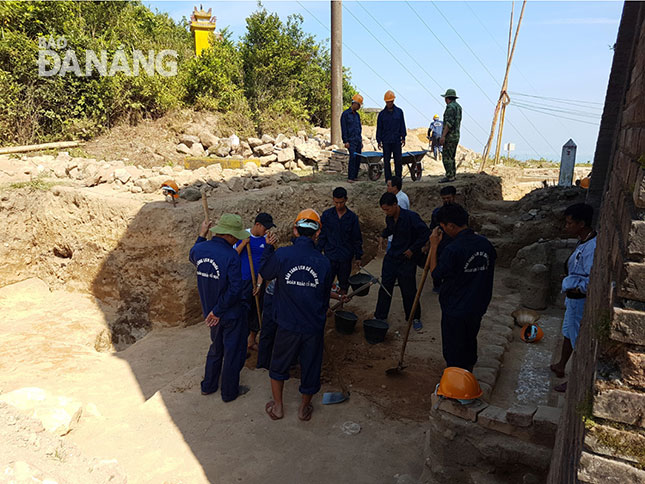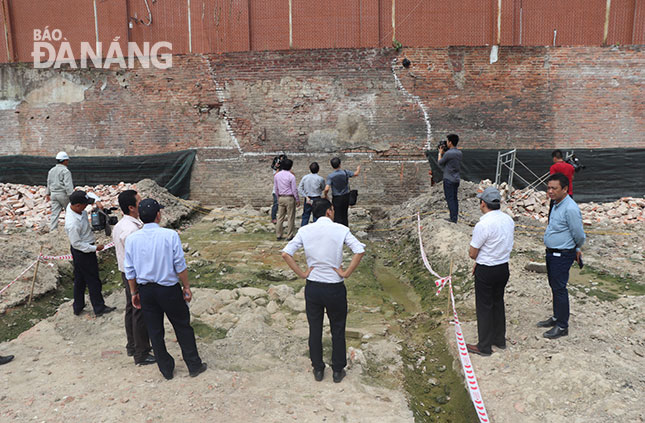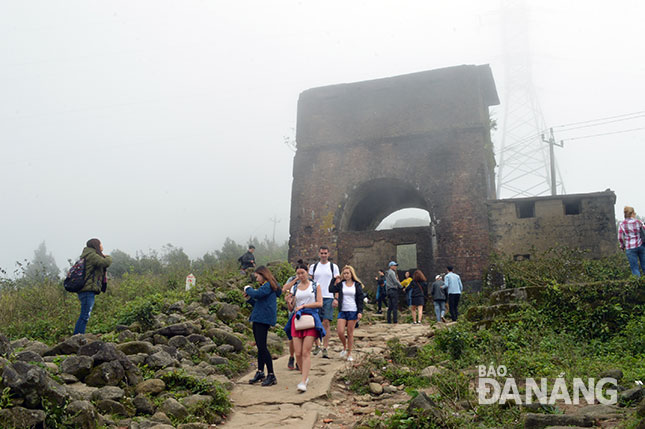Excavation: 'must-do' for restoration of relic sites
Excavations are now underway at popular relic sites in Da Nang, namely the Dien Hai Citadel and the Hai Van Gate, both of which show off profound historical, architectural and artistic value. The excavation work is considered to be a 'must-do' task in implementing the restoration and embellishment of these venues.
 |
| The excavation getting underway at the Hai Van Gate |
During the ongoing implementation of the 1st stage of a project featuring the restoration and embellishment of the Dien Hai Citadel located in the downtown district of Hai Chau, construction units discovered some remains of walls and foundations at this newly-recognised special national-level relic site.
In detail, an over 130m-long wall section, made from bricks of different sizes and mortar, was found to the west of the citadel.
In addition, a 14.2 long, 4.2m-wide section of the foundation, which was built from laterite and pebble, was also explored next to the citadel wall on the western side.
The excavation team suggested measuring the original section of the wall and foundation, and dismantling broken or damaged brick sections for restoration.
The excavators will have to revaluate the section of foundation on the western side of the citadel, due to a lack of original documents and drawings.
 |
| A14.2 long, 4.2m-wide section of the foundation was explored next to the citadel wall on the western side. |
The 1st stage of the restoration and embellishment project, which started in late March, is scheduled to be completed by late October at a total cost of over 102.7 billion VND (over 4.4 million USD).
Of this, 80 billion VND (3.5 million USD) is earmarked for compensation for the displaced families, whilst the remainder is spent on restoring the damaged walls and trenches, building water supply and drainage systems, creating green areas, and a parking lot, plus other auxiliary facilities.
The citadel still has a moat between 2 brick walls and a cannon collection displayed outdoors. It has a total dimension of 653m, including 2 layers of walls (5.64m high inner walls and 3.29m outside wall), and a trench system 21.15m wide and 3.29m deep.
Another excavation began on an area of 600m2 on the Hai Van Gate which sits at the top of its namesake mountain pass located at the geographical boundary between the city and Thua Thien-Hue Province. This site which is the joint-owned cultural heritage of the 2 localities was officially recognised the Hai Van Gate as a national relic site in April by the Ministry of Culture, Sports and Tourism.
 |
| Domestic and foreign tourists visit the Hai Van Gate |
The venue is a complex of brick-built gates dating from the Tran Dynasty (1470), and octagonal bunkers from the French colonial period. The gate had at one point been left to fall into disrepair, but nowadays, it has emerged as one of the must-see places in the city.
After over 10 days of excavation, many remains of the venue have been unearthed, including stair steps, sections of the foundation of the gate, and the entrance path to the site, which all were all built during the Nguyen Dynasty.
The excavation team are searching for damaged items, and will preserve the current buildings (two bunkers and the concrete roof of the southern gate), as well as the brick gate and stone walls.
According to historical researchers, both Dien Hai Citadel and Hai Van Gate boast the great cultural and historical values; hence, the restoration should be implemented in a carefully controlled way.
Mr Hoang Van Thuong from the National Museum of Vietnamese History, who is being in charge of the excavation at the Hai Van Gate, said the process of restoration is a highly specialised operation. The intention is to preserve and reveal the aesthetic and historic value of the monument, and the whole process is based on respect for original material and authentic documents.
The restoration in any case must be preceded and followed by an archaeological and historical study of the monument. Accordingly, excavations should be carried out in accordance with scientific standards and the recommendation defining international principles to be applied in the case of archaeological excavation adopted by UNESCO in 1956.
Ruins must be maintained and measures necessary for the permanent conservation, and protection of architectural features and of objects discovered must be taken. Furthermore, every means must be taken to facilitate the understanding of the monument and to reveal it without ever distorting its meaning.
Replacements of missing parts must integrate harmoniously with the whole, but at the same time must be distinguishable from the original so that restoration does not falsify the artistic or historic evidence.
According to Mr Ha Vy, the Deputy Director of the Da Nang Department of Culture and Sports, on the basis of the archaeological findings at the Dien Hai Citadel, adjustments to the restoration design plans for this venue will be made carefully.